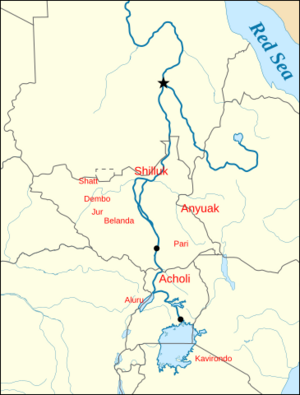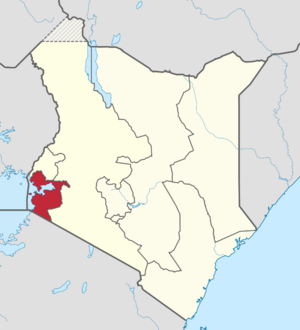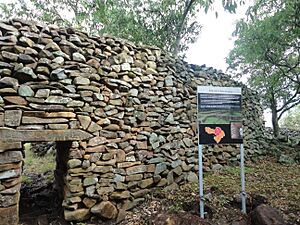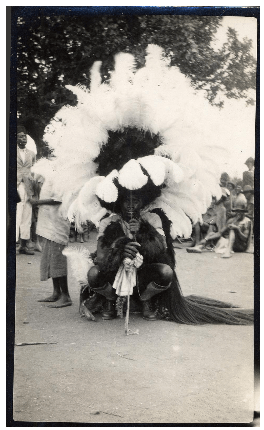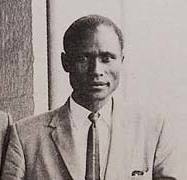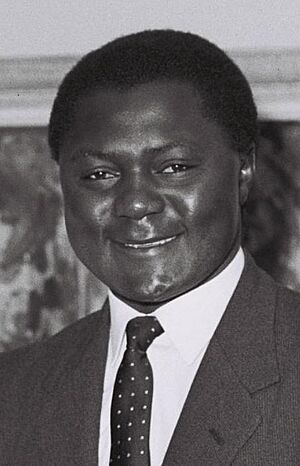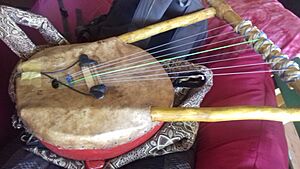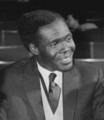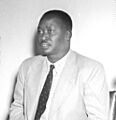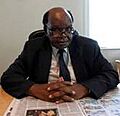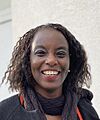Luo people facts for kids
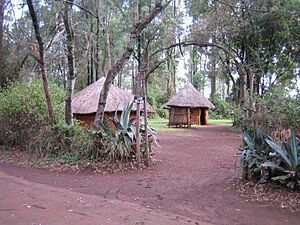
A traditional Luo village at the Bomas of Kenya museum.
|
|
| Total population | |
|---|---|
| 10,028,000 | |
| Regions with significant populations | |
| Western Kenya and northern Tanzania | |
| 4,663,910 (2019) | |
| Languages | |
| Dholuo, Swahili, and English | |
| Religion | |
| Christianity, African Traditional Religion, Islam | |
| Related ethnic groups | |
| Other Luo peoples, especially Adhola and Alur | |
| Luo | |
|---|---|
| Person | Jaluo (m)/Nyaluo (f) |
| People | Joluo |
| Language | Dholuo |
| Country | Piny Luo/Nam Lolwe |
The Luo are a large group of people living in western Kenya and northern Tanzania in East Africa. They are part of a bigger group called Nilotic peoples. In Kenya, the Luo are the fourth-largest ethnic group. In 2001, about 1.1 million Luo lived in Tanzania, growing to 3.4 million by 2020. They are connected to other Luo groups found in places like South Sudan, Ethiopia, and Uganda.
The Luo speak a language called Dholuo. This language is part of the Nilotic language family. Dholuo is very similar to languages spoken by other Luo groups.
The Luo people came to western Kenya from Uganda. This happened in four main waves between the 15th and 20th centuries. These early migrants were related to Luo groups in Uganda, like the Acholi and Padhola people. As they moved into Kenya and Tanzania, they mixed with other communities already living there. This mixing changed their genes and culture.
Long ago, the Luo people made a living in several ways. They raised cattle, grew crops, and went fishing. They also hunted animals. Today, many Luo people work in skilled jobs in East Africa. They are also involved in fishing, small-scale farming, and city jobs.
Many Luo people have made important contributions to modern culture. Tom Mboya was a key leader in the fight for African independence. Scientists like Thomas Risley Odhiambo Nandy and Washington Yotto Ochieng have gained international fame. Professor Richard Samson Odingo was part of the group that won the Nobel Peace Prize in 2007. Barack Obama, the first black President of the United States of America, has a Kenyan Luo father. Lupita Nyong'o won an Academy Award in 2014, becoming the first black African to do so.
The Luo are also known for creating popular music styles. These include benga and ohangla. Benga is one of Africa's most popular music types.
Contents
Where the Luo Live
The Luo people in Kenya and Tanzania live near Lake Victoria. This area is in western Kenya and northwestern Tanzania. It is located near the equator and gets a good amount of rain. The land here is between 3,700 and 6,000 feet above sea level.
The Luo Story: Where They Came From
Early Beginnings
The Luo people in Kenya and Tanzania are mostly from the Nilotic peoples. During the time of British rule, they were called Nilotic Kavirondo. Experts believe the Nilotic peoples first lived between Bahr-el-Ghazal and Eastern Equatoria in South Sudan. They raised cattle, fished, and grew crops. Old discoveries at a place called Kadero in Sudan show a similar culture from 3000 BC. This site has remains of cattle herders and people who looked like Sub-Saharan Africans.
Studies show that people similar to the Nilotic groups lived in the Nile valley long ago. For many reasons, Luo people slowly moved from South Sudan into Uganda and western Kenya. This happened from about 1000 AD until the early 1900s. Some say this move happened when Christian kingdoms in Sudan fell apart. It also happened when Nilotic people started using iron tools.
The Luo of Kenya and Tanzania are called Southern Luo. They are known as 'river lake Nilotes' because they lived along the Nile river. They came into Kenya and Tanzania through Uganda. They were mainly from four Luo-speaking groups: the Acholi, Adhola, and Alur people.
The Luo people in Kenya and Tanzania are also called Joluo or Jonagi. A single person is called Jaluo. The word Jonagi means "people who had their six lower teeth removed." This was a special custom during puberty. The Luo clans in Kenya and Tanzania were called Ororo. Today, the Kenyan Luo have 27 tribes, each with many clans.
Moving into Kenya
Stories passed down through generations help us understand when the Luo moved into Kenya and Tanzania. There were four main waves of migration into the former Nyanza province in Kenya. The first group, Joka Jok, arrived around 1490–1517. They were the largest group and settled at Ramogi Hill. Then they spread around northern Nyanza.
Other groups, Jok’Owiny and Jok’Omolo, followed around 1598–1625. Later, groups like the Suba also joined. The Suba were originally Bantu-speaking people. They became part of the Luo culture after fleeing from the Buganda Kingdom in Uganda. Luo speakers crossed Winam Gulf of Lake Victoria into South Nyanza in the early 1600s.
As the Luo moved into western Kenya, they met people who had lived there for a long time. The Great Lakes region has been home to people since the early Stone Age. The Kanysore culture, found in Migori County, were likely the first hunter gatherers in East Africa to make pottery. Bantu speakers arrived in western Kenya by 1000 BC. They brought iron tools and new farming methods. This made the region an important center for people and iron making.
When the Luo expanded, they traded, fought, and married with other groups. They also shared cultures. This led to the building of stone walls and earthworks for defense, like Thimlich Ohinga. These structures protected homes. When Europeans arrived, these defensive sites were slowly left empty. Families moved to individual homes, using plants instead of stone for fences. By the mid-1900s, all these sites were abandoned.
During Colonial Times
The British first had little contact with the Luo. This changed when the Uganda Railway was built. In 1896, the British fought against the Kager clan, killing many people with a Maxim gun. Another 300 people were killed when the British took Luo cattle to feed railway workers. After these fights, Luo spiritual leaders told their people to work with the British.
By 1900, a Luo chief named Odera helped the British with 1,500 porters. The British set up their main offices in Mumias and then Kisumu. They worked to bring the Luo under their control. In a few decades, traditional leaders were replaced by colonial chiefs.
Christian missionaries, especially the Seventh-day Adventists, came to the Luo people early on. Arthur Carscallen was one of the first Adventists to work in Kenya. He opened the first mission in 1906 at Gendia Hill. These missionaries set up stations in different areas. The first Luo people were baptized as Adventists in 1911. Carscallen also wrote down the Dholuo language and started translating the Bible. Catholic and Anglican missionaries were also active.
It is not clear if the Luo changed their ways because of British pressure or if they accepted Western culture easily. However, by the 1930s, the Luo way of life had changed a lot. Some say chiefs like Odera Akang'o helped this change. In 1915, the British sent Odera Akang'o to Kampala, Uganda. He was impressed by the British settlement there. When he returned, he made his people adopt Western schooling, dress, and hygiene. This led to quick education in English for the Luo.
A movement called Mumboism started in South Nyanza. In 1913, Onyango Dunde said he was sent by a serpent god from Lake Victoria. This god wanted to drive out the colonialists. The colonial government saw this as a threat. They arrested and imprisoned followers of Mumboism in the 1920s and 1930s.
Early African political groups in Kenya Colony protested against unfair policies and high taxes. Luo people in Kavirondo and Kikuyu people in Nairobi held large meetings. A strike at a mission school was organized to protest land ownership changes. Meetings called Piny Owacho (Voice of the People) asked for individual land ownership and fair taxes. James Beauttah helped create an alliance between the Kikuyu and Luo.
Oginga Odinga started the Luo Thrift and Trading Corporation (LUTATCO). He wanted to improve the Luo community's economy. The LUTATCO office was the first African-owned building in Kisumu Town. It also published African Nationalist newspapers. For his efforts, Oginga Odinga was made ‘Ker’ (Chief) of the Luo Union. This group represented Luo people in East Africa. Oginga Odinga later became a key political figure in Kenya.
The Mau Mau Uprising
White settlers did not take land from the Luo people as much as from other groups. Many Luo played important roles in Kenya's fight for independence. However, they were not as involved in the Mau Mau Uprising (1952–60). Instead, they used their education to work for independence peacefully. The colonial government spread propaganda against the Mau Mau. This made other Kenyans and the world less sympathetic to the movement.
The Mau Mau uprising was mainly supported by the Kikuyu people. Luo supporters of Mau Mau were also imprisoned. Ramogi Achieng Oneko, a leader, was one of the Kapenguria Six. Barack Obama's grandfather, Hussein Onyango Obama, was involved in the African nationalist movement. He was tortured by colonial authorities because they thought he was involved in the Mau Mau rebellion. Luo lawyer Argwings Kodhek defended Africans accused of Mau Mau crimes for free.
Politics Before Independence
After the Mau Mau uprising was stopped, Luo leaders became very important in politics. Tom Mboya became a major figure in the fight for Kenya's independence. He was known for his intelligence and speaking skills. Tom Mboya started the Kenya Federation of Labour (KFL), which became a powerful political group. He also made international connections, especially in the United States of America.
Tom Mboya started the Nairobi People's Convention Party (NPCP). This party later joined with others to form the Kenya African National Union (KANU). KANU ruled Kenya until 2002. Tom Mboya also created the Kennedy Airlift scholarship program. This program helped over 800 Kenyans and East Africans study abroad. Among them were Wangari Maathai and Barack Obama Sr.
In 1957, Tom Mboya and Oginga Odinga were elected to the Legislative Council. In 1958, Oginga Odinga called for the release of Jomo Kenyatta, who was in prison. This call became a rallying cry for the independence movement. The Lancaster House Conferences were held in London to plan Kenya's independence. Tom Mboya and Oginga Odinga got help from an American lawyer, Thurgood Marshall, to write the first constitution.
Independent Kenya
Kenya became independent on December 12, 1963. Oginga Odinga became the Vice President, with Jomo Kenyatta as the head of government. They were part of the Kenya African National Union (KANU) party. The Luo and Kikuyu people held most of the political power at first. However, differences with Kenyatta caused Odinga to leave the party in 1966.
Politics in Kenya were affected by the Cold War. Odinga and Bildad Kaggia criticized the government's land policy, saying it did not help the poor. Pio Gama Pinto, a key activist, was killed in 1965. Odinga was increasingly pushed aside and eventually resigned. He started his own party, the Kenya People's Union (KPU), which had strong support among the Luo. The Kenyatta government made it hard for this party to operate. They arrested KPU members without trial.
Tensions grew in 1969. The Luo became less powerful in politics. Argwings Kodhek died in a mysterious car crash. Tom Mboya, who many thought would be the next leader, was killed in July 1969. This led to the Kisumu massacre, where police killed civilians in Kisumu Town. After this, KPU was banned, and Kenya became a one-party state. All KPU members, including Oginga Odinga, were arrested. The Luo community faced more political challenges under the Moi government.
Oginga Odinga was released in 1971. The government still tried to stop him from being active in politics. In 1982, Odinga tried to start a new party. But the Kenyan constitution was changed to make Kenya a one-party state. A coup attempt by the Kenya Air Force that year, led by a Luo, Hezekiah Ochuka, failed. Oginga Odinga and his son Raila Odinga were accused of being involved and were detained. These events led to many years of challenges for the Luo community.
In the early 1990s, pressure from inside and outside Kenya led to changes. Multi-party politics was allowed again. The Forum for the Restoration of Democracy (FORD) was formed. This party later split into different groups. Oginga Odinga's son, Raila Odinga, started the National Development Party of Kenya (NDP). This party had strong Luo support.
In 2002, Raila Odinga helped Mwai Kibaki win the presidential election. However, their relationship turned bad. In 2007, the general elections led to a crisis. More than 1,000 people were killed, and 600,000 were displaced. The election was divided along ethnic lines. A power-sharing agreement was reached, and Raila Odinga became Prime Minister. The rivalry between the Kikuyu and Luo still affects Kenya's politics.
Despite these challenges, many Luo people continue to achieve great things in Kenya. These include James Orengo, Professor Anyang' Nyong'o, and Dr. PLO Lumumba. Lupita Nyong'o won an Academy Award for Best Supporting Actress in 2014. Famous Luo scientists include David Peter Simon Wasawo, Thomas R. Odhiambo, and Washington Yotto Ochieng.
Luo Culture and Customs
How They Governed Themselves
Traditionally, the Luo people had a system where the father was the head of the family. Many families related by blood formed a clan. Many clans formed a village, led by a village elder. Several villages formed a sub-tribe, led by a hereditary chief called Ruoth.
The Ruoth had a council of elders from all the villages. This council helped the Ruoth make decisions. The Luo organized their defense at the sub-tribe level, led by a commander. There was no single ruler for all Luo people. Sub-tribes helped each other during wars or natural disasters like famine. Sharing food with those affected by famine was a common tradition.
The idea of a single Luo ruler, ker, was created by Jaramogi Oginga Odinga in 1947. This was when the Luo Union was formed to unite all Luo people in East Africa. Oginga Odinga was the first Luo Ker. When he entered national politics in 1957, he had to stop being the Ker.
In recent years, there have been arguments over who is the true Luo Ker. Traditionally, the Ker was elected by elders and could only leave office by resigning or dying.
Life Passages and Names
Luo children's names often showed things about their mother's pregnancy or birth. For example, the time of day or season they were born.
Also, the Luo people traditionally removed six lower teeth. This was done because of a jaw disease that affected the Luo land.
What They Eat
A popular Luo meal includes fish, especially tilapia and omena. This is usually eaten with ugali (called kuon in Dholuo). They also eat traditional vegetables like osuga and apoth. Long ago, Luo people ate kuon made from sorghum or millet with fish, meat, or vegetable stews.
Religious Practices
Like many groups in Uganda, the Luo do not practice ritual circumcision for males as a way of becoming an adult.
Local churches include Legio Maria and Nomiya. There are also Luo Muslim communities, especially in Kisumu.
Marriage Customs
In the past, matchmakers helped couples meet. This is not common now. Like other communities in Kenya, Luo marriage customs are changing. Many people are moving away from traditional ways.
The Luo successfully grew their culture by marrying people from other groups. Many Luo today still marry outside their community. This is generally accepted. The traditional marriage ceremony has two parts. Both involve the groom paying a bride price. First, money is paid to the bride's mother. Second, cattle are given to her father. Often, these two steps happen at the same time. Many modern Luo are Christians, so a church ceremony often follows.
Music and Dance
Music was a very important art form for the Luo. It was played at any time of day or night. Music was not just for fun; it had a purpose. It was used for ceremonies, religious events, political gatherings, or just everyday life. For example, music was played at funerals to honor the dead and comfort those who were sad. It also helped people stay awake at night and express their pain. Music was also used for cleansing and chasing away spirits.
Music was also part of celebrations like parties, welcoming warriors home, wrestling matches, and courtship. There were also work songs for group tasks like building or weeding. Music was used for rituals, such as chasing away evil spirits or making rain.
Luo music had special features that made it different from other cultures' music. You could see, hear, and feel this in their melodies, rhythms, and dance styles. Luo melodies were often lyrical with many vocal decorations. Their rhythms had a lot of syncopation, meaning the beats were off-beat. Songs were usually sung with a leader singing a part and a group responding. Some songs were sung by one person, like chants. These chants had irregular rhythms and carried important messages. Many Luo dances started with these chants.
Another special thing in Luo music was a chant in the middle of a performance. The singing would stop, the instruments would play softer, and the dancing would slow down. One person would then praise themselves. This was called Pakruok. There was also a unique sound called Sigalagala, usually made by women, which marked the most exciting part of the music.
Luo dance styles were elegant and graceful. They involved moving one leg in the opposite direction of the waist, matching the music's rhythm. Or they involved shaking the shoulders strongly, often to the sound of the nyatiti, an eight-stringed instrument.
The Luo wore special costumes and ornaments during performances. These included sisal skirts (owalo), beads (Ombulu / tigo) worn around the neck and waist, and red or white clay for women. Men wore skin coverings (kuodi or chieno'), headgear (Ligisa'), and carried shields and spears. All these were made from local materials.
The Luo had many musical instruments. These included drums, clappers, metal rings, shakers, and string instruments like the nyatiti (a type of lyre) and orutu (a type of fiddle). They also had wind instruments like horns (tung) and flutes (Asili).
Today, the Luo are known for benga. This is a lively style where songs are sung in Dholuo, Swahili, or English, with a strong guitar sound. It started in the 1950s when Luo musicians tried to use Western instruments for their traditional dance rhythms. The guitar replaced the nyatiti as the main string instrument. Benga has become popular with musicians from all ethnic groups.
Luo singer and nyatiti player Ayub Ogada became famous in 2005. Two of his songs were used in the movie The Constant Gardener. Other famous Luo musicians include Akothee, Suzanna Owiyo, and Tony Nyadundo.
Family and Inheritance
In Luo tradition, when land or property is passed down, the oldest son gets the largest share. The second son gets land to the right of the home, and the third son gets land to the left. After the father dies, the oldest son takes over leadership. These groups, related by a common grandfather, are called Jokakwaro. They share sacrifices led by the oldest brother. If he dies, the next oldest brother takes over.
The oldest brother also gets special parts of animals killed for food. He is the first to own a fishing boat. He also talks to the ancestors and leads religious ceremonies for the boat.
If a father divides land while he is alive, the oldest son gets the middle part of the land. The second son divides the rest with other brothers. The youngest son often stays in the father's village to care for him. He inherits the last property and his mother's gardens.
In families with more than one wife, the land is divided based on each wife and her children. The children of the first wife get the largest share, similar to what the oldest son would get in a family with one wife. The children of the second and third wives get parts that would go to the second and third sons.
Notable Luo People
- Notable people
-
Apollo Milton Obote
First Uganda's Prime Minister, and former two-time president -
Barack Obama
44th President of the United States of America -
Tom Mboya
Statesman. One of Kenya's founding fathers. -
Susan Mboya
Corporate executive and philanthropist -
Lupita Nyong'o
Actress. First black African Academy Award winner -
Oginga Odinga
First Vice-President of Kenya -
Johnny Oduya
Professional Ice-Hockey defenceman -
Margaret Ogola
Paediatrician and Author. Winner of the 1995 Commonwealth Writers' Prize -
Dennis Oliech
Professional Footballer -
David Otunga
Actor, Lawyer, former WWE professional wrestler
|
See also
- Arthur Carscallen, who wrote the first Dholuo grammar and dictionary.
- Kisumu City - The third-largest city in Kenya.
- Gor Mahia FC - A Kenyan football club.
- Legio Maria, a large religious group from Luoland.
- Luo peoples - Other related Nilotic ethnic groups.
- Luo Union (Welfare Organisation) - A past organization that united Luo peoples in East Africa.


